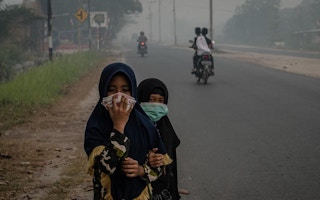Although millions of Southeast Asians have suffered health complications and other harmful effects of haze pollution for more than 40 years, few parties have been held legally accountable for man-made fires as the region continues to lack potent laws and enforcement to fight transboundary haze.
To continue reading, subscribe to Eco‑Business.
There's something for everyone. We offer a range of subscription plans.
- Access our stories and receive our Insights Weekly newsletter with the free EB Member plan.
- Unlock unlimited access to our content and archive with EB Circle.
- Publish your content with EB Premium.
Ahead of an Association of Southeast Asian Nations (Asean) leaders’ meeting on transboundary haze in Singapore on 7 and 8 June, experts and environmentalists have amplified calls for policymakers to implement and enforce regulations that will hold polluters accountable for activities that contribute to regional haze pollution. This comes as meteorological departments around the region began issuing warnings of the return of the hot and dry El Niño weather phenomenon.
In Malaysia, environmental group Greenpeace invited experts and artists to contribute to a public art exhibition and panel discussion in May. It also called for members of the public to sign a petition urging the government to implement stronger policies and legislation to protect the public’s right to clean, haze free air.
Greenpeace ran a similar campaign in Thailand at the Bangkok Art Culture Centre last week.
“The government needs to make outdoor air quality standards legally binding, time-bound and enforceable through the implementation of stronger policies and laws, such as a Clean Air Act,” Greenpeace Malaysia said.
Of Asean’s ten member states, only Singapore has a domestic Transboundary Haze Pollution Act, effective 2014. A year later, the country’s National Environment Agency (NEA) took action against Indonesian pulpwood giant Asia Pulp & Paper and a handful of smaller companies, serving them notices on preventive measures which prompted outrage in Indonesia. NEA’s case against APP is still pending, nine years later.
Meanwhile, Malaysia made plans to table a transboundary haze bill in 2019, but this was scrapped in 2020 following a change in government. Current minister of natural resources, environment and climate change Nik Nazmi Nik Ahmad said earlier this month that plans for the transboundary haze act are still under review.
“The ministry needs to take into account the challenges of obtaining evidence for prosecution purposes, which involves data related to security, and the sovereignty of the country responsible for the haze pollution,” he told local media. Nik Nazmi cited Singapore’s challenges in implementing its Transboundary Haze Pollution Act, which cannot be enforced against entities governed by other countries.
Malaysia has the opportunity to learn from Singapore’s experience in designing a more effective law, said Dr Helena Varkkey, associate professor at the University of Malaya, who has 15 years of experience in transboundary haze research.
“The Malaysia law should cover only Malaysian companies, and should only be applied when other countries are unwilling or unable to effectively enforce their own laws,” she told Eco-Business.
Furthermore, the law should focus on being more preventative than punitive in order to encourage the buy-in of Malaysian companies, she said. This would include providing legal grounds to institutionalise checks and balances on the operations of Malaysian companies, both locally and abroad.
Dr Noppachai Fongissara, assistant professor at Thailand’s Chiangrai Rajabhat University, agreed that domestic laws could be a good starting point for Asean member states, especially in northern member countries such as Thailand, Laos and Myanmar. While leaders of the three countries recently held talks and discussed potential joint action plans, no legislative action was proposed. The Mekong region recently suffered persistent haze conditions which intensified from late January until the end of April.

Visitors take photos at the “Haze: Coming Soon” art exhibition organised by Greenpeace Malaysia. Meteorological departments across Southeast Asia have warned about the potential return of transboundary haze, due in part to a resurgence of the El Niño weather phenomenon. Image: Samantha Ho/Eco-Business
Although countries can only control what happens within their own borders, provisions should be implemented to cover activities by domestic companies operating overseas, Fongissara told Eco-Business. Any regional agreements or laws designed to address transboundary haze pollution should also include a form of punishment in addition to encouraging collaboration, he said.
Even without specific domestic laws targeting haze pollution, however, citizens in Indonesia were able to hold the government accountable for poor air quality in the capital, Jakarta. In September 2021, an Indonesia court found president Joko Widodo and other senior government officials guilty of environmental negligence for failing to improve the city’s air quality following a suit filed by 32 plaintiffs in 2019. The officials were ordered to devise strategies and take measures to control air pollution.
In Malaysia however, various issues surround indentifying and proving the causation of activities that lead to haze carried by transboundary air particles, said environmental lawyer Kiu Jia Yaw, who is co-chair of the Bar Council Environment and Climate Change Committee.
As such, Malaysia has yet to penalise polluters in court even though the country’s former chief justice Tun Richard Malanjum, now ombudsman of the United Nations’ Security Council, has long called on environmental lawyers to bring cases on transboundary haze to court so that judges could play a role in trying to hold responsible parties accountable, Kiu said. Speaking at a panel disucssion hosted by Greenpeace Malaysia, he called transboundary haze “a phenomenon that results from organised irresponsibility.”
‘Asean Way’: a roadblock for cross-border haze management
It is especially challenging to seek cross border recourse for transboundary haze pollution in Southeast Asia due to the ‘Asean Way’, which encourages non-confrontational approaches towards cross-border issues and upholds the principles of national sovereignity and non-interference. Research by academicians in countries including Thailand, Malaysia and Indonesia have shown that the Asean Way is largely responsible for the ineffectiveness of the Asean Agreement on Transboundary Haze Pollution (AATHP), which requires that members cooperate on the prevention, monitoring and mitigation of transboundary haze pollution.
Although the agreement was signed by all member states in 2002, it took Indonesia 12 years to ratify the AATHP, making it the last Asean country to do so in 2014.
Haze action in Asean
1992: Transboundary haze pollution was first highlighted at the 4th Asean Ministerial Meeting on the Environment.
1993: The Asean Specialised Meteorological Centre (ASMC) was established to monitor and assess forest fires and transboundary haze.
1995: The first Asean meeting on the management of transboundary pollution was held in Kuala Lumpur and the Asean Cooperation Plan on Transboundary Pollution was adopted.
1997: The first Asean Ministerial Meeting on Haze was specifically convened. The Asean Regional Haze Action Plan was formulated.
1998: The Hanoi Plan of Action was adopted to facilitate fire fighting resources.
2002: The Asean Agreement on Transboundary Haze Pollution (AATHP) was signed by all Asean member states. The agreement requires that members cooperate and implement measures to prevent, monitor and mitigate transboundary haze pollution.
2007: The Asean Transboundary Haze Pollution Control Fund was established to implement the AATHP, with an initial target amount of US$500,000.
2013: The Asean Taskforce on Peatlands was established to monitor and support the implementation of relevant peatland strategies.
2014: AATHP was ratified by all member countries 12 years after it was first signed, after Indonesia voted in favour of the agreement.
“Asean hestiated to judge Indonesia’s non-ratification and as a result, compromised on its own agreement,” said Fongissara and co-author Watcahrabon Buddharaksa in a recent paper, which concluded that the AATHP had failed.
Member states have also appeared to challenge the validity of data from the Asean Meteorological Centre (ASMC), which was established to assess and monitor fires across the region. For instance, neighbouring countries took to finger-pointing over the sources of transboundary haze in 2019.
While Malaysia cited data from the Asean Specialised Meteorological Centre that showed how the haze originated in Indonesia’s Kalimantan and Sumatra islands, Indonesia denied this, saying that the haze had originated in the Malaysian state of Sarawak.
As a result, regional discussions tend to focus on validating and verifying data, limiting space for discussions on the implementation of mitigation activities, said Varkkey.
A lack of accessible concession maps has also hampered the efforts of researchers and civil society organisations to effectively identify the parties responsible for fire hotspots, she said. In Malaysia, where fires start easily on peatlands drained for oil palm plantations, authorities have agreed to make land maps of the palm oil industry publicly available.
However, Indonesia has has yet to do the same although its peatlands have also been drained for palm oil and pulp and paper production.
On top of this, political patronage has also made it challenging for policymakers to effectively fight transboundary haze, according to Varkkey’s research published in 2015. She found that although forest clearing occurred in Indonesia, many of the companies involved are headquartered in Malaysia and Singapore and of these, a large number have close relationships with the politicians and officials responsible for addressing the problem.
But there is some room for optimism, as heightened pressure on the relevant authorities and companies in the years since the publication have helped improve practices related to fire and haze management.
“The fact that there’s so much more scrutiny on both companies and governments since the time of my fieldwork means that both (sectors) are forced to act more responsibility. Even though some problems still remain, there has definitely been improvements: for example, there have been less cases of intentional fires,” Varkkey told Eco-Business.
In the meantime, companies should be required to disclose “high fidelity” information in their sustainability reports, said Kiu, in order to improve access to transparent high quality data for regulators and civil society organisations. Varkkey and Kiu are both members of the Clean Skies for All (CERAH), a civil society organistion in Malaysia that aims to raise awareness of transboundary haze and now to fight it.










